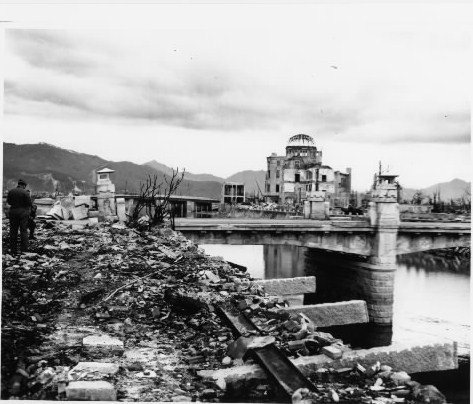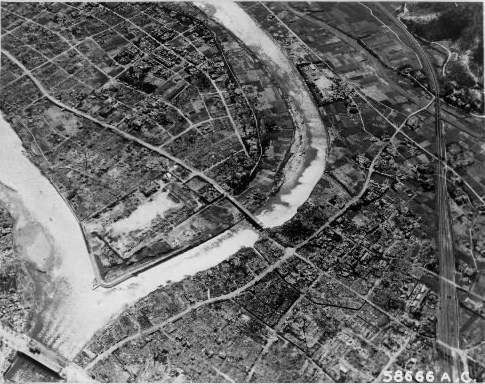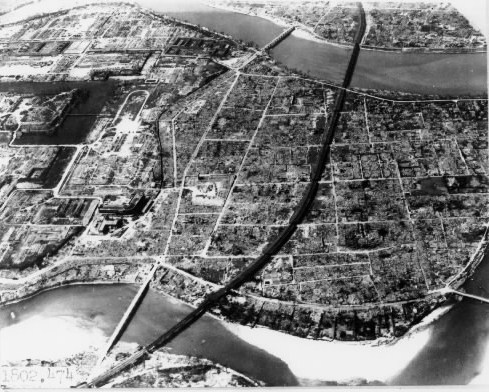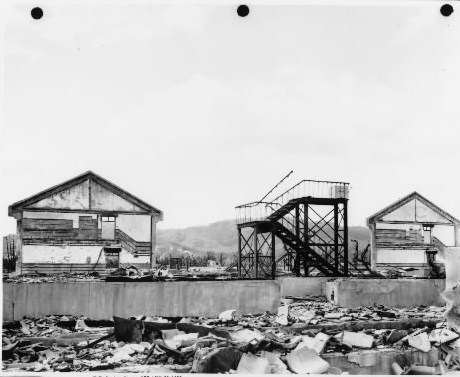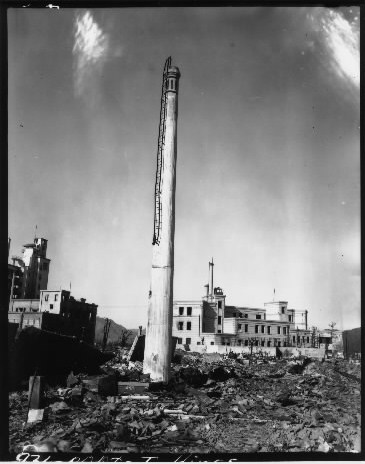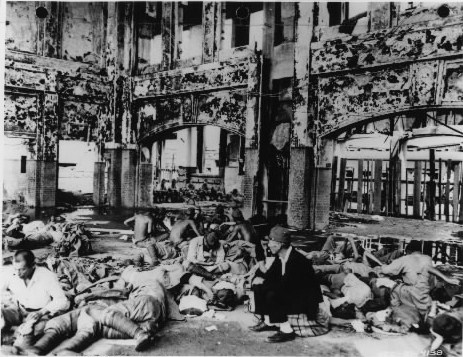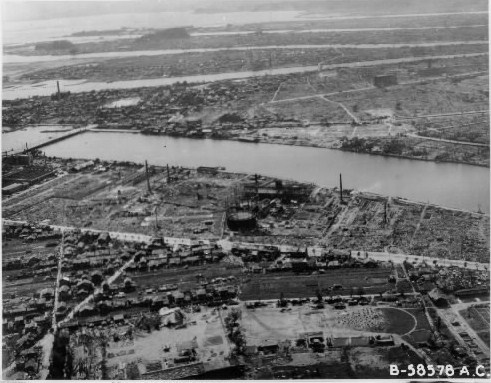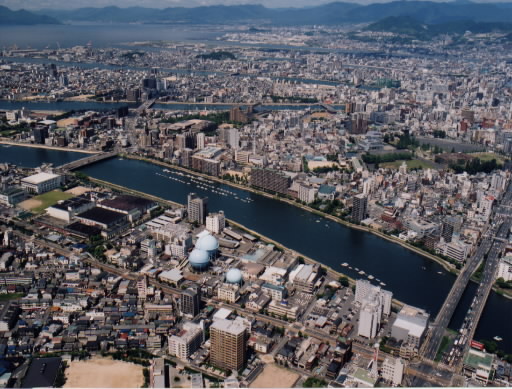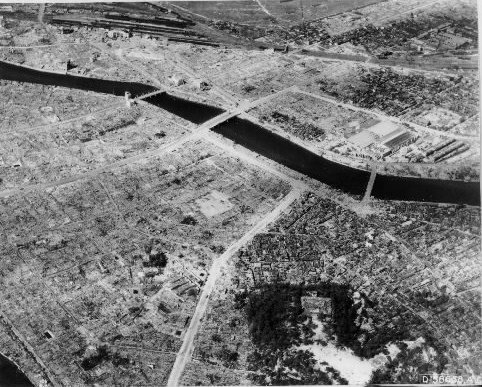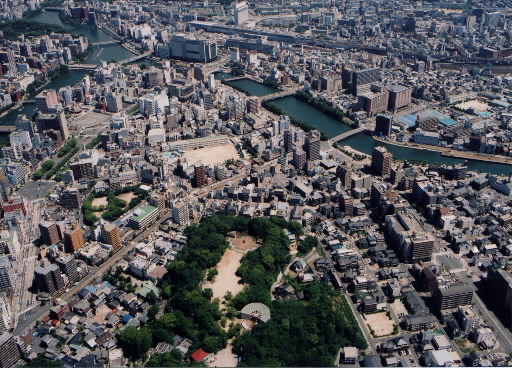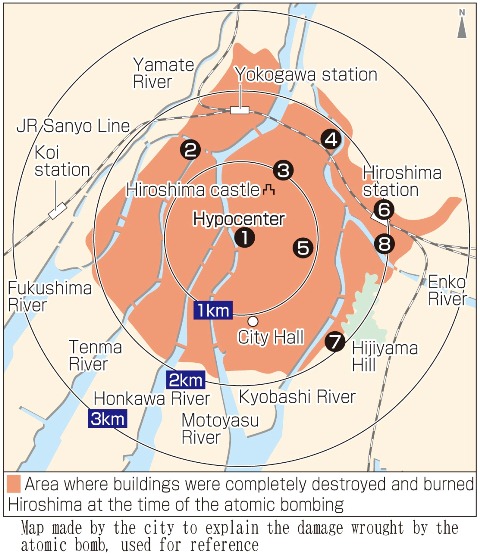- A-bomb Images
- Record of Hiroshima: Photographs clearly show boundary of area where buildings were completely destroyed and burned
Record of Hiroshima: Photographs clearly show boundary of area where buildings were completely destroyed and burned
by Masami Nishimoto, Senior Staff Writer
On June 19, the Hiroshima Peace Culture Foundation announced that it had obtained 226 photographs related to the Hiroshima atomic bombing from the United States’ National Archives in College Park, Maryland. The images are copies made from original films or prints and depict the city with much more clarity than others available to this point. These photos, taken from the sky or on the ground, show parts of the city that have not been seen in previous photos. To Hiroshima, the images, taken by American military forces to evaluate the effectiveness of the atomic bomb, are materials which tell the tragedy wrought by the atomic bombing. With the help of Michio Ide, 62, a photographer and a member of the Materials Research Committee at Hiroshima Peace Memorial Museum, we will examine the reality of the bombing through these photos.
To investigate the power of the atomic bomb and the presence or absence of residual radiation, U.S. forces had the U.S. Manhattan District Survey Team and a joint Japan-U.S. survey team enter Hiroshima on September 8 and October 12, 1945, respectively. Meanwhile, a film crew from the U.S. Strategic Bombing Survey took numerous photos to create a detailed record between October 14 and November 26.
Mr. Ide has been examining photos of the atomic bombing at the request of Peace Memorial Museum for the last five years. He said, “Some of these photos show a scorched plain, so it seems that they were taken shortly after the atomic bombing.” He believes that a majority of them were taken between mid-August and November.
The photos reveal how much effort went into recording the range of damage caused by the atomic bomb, used by U.S. forces in warfare for the first time in human history. Some photos of ground zero were taken by low-flying aircraft, only 300 to 500 meters above the earth. Photos were also taken of the area within a roughly two-kilometer radius around the Hiroshima delta where seven rivers (now six rivers) once flowed. These images clearly show the boundary of the area where all buildings were completely destroyed and burned.
Also photographed was the Hiroshima Army cadet school’s fire protection wall, which did not collapse in the blast. The idea was to record the connection between the atomic bombing and the strength of both wooden and non-wooden structures.
In 1973, 1,205 photographs related to the atomic bombing, including images taken by Japanese photographers that had been confiscated by the U.S. military, were returned to Hiroshima. In 1974, Hiroshima Peace Memorial Museum, and in 1978, the Japan Peace Museum, a citizens’ group based in Tokyo, began obtaining photographs held by the National Archives. It is estimated that there are about 1,000 photos of the atomic bombing of Hiroshima, after copies of the same photos are excluded.
Currently, more than 400 photos can be seen in the photo collections that have been published to date. But more than a few of these images have been printed with the right and left sides reversed or include errors in their captions. This is due to a lack of in-depth study of the materials.
Mr. Ide comment, “We’ll be able to discover things we don’t yet know by accurately sorting the photos according to when and where they were taken and by examining them fully.” He suggested that relevant organizations in Hiroshima must work together on this task. Considering the time remaining to obtain the testimonies of A-bomb survivors, there is a pressing need to put together the entire picture of the bombing through these photographs.
(Originally published on June 20, 2003)
On June 19, the Hiroshima Peace Culture Foundation announced that it had obtained 226 photographs related to the Hiroshima atomic bombing from the United States’ National Archives in College Park, Maryland. The images are copies made from original films or prints and depict the city with much more clarity than others available to this point. These photos, taken from the sky or on the ground, show parts of the city that have not been seen in previous photos. To Hiroshima, the images, taken by American military forces to evaluate the effectiveness of the atomic bomb, are materials which tell the tragedy wrought by the atomic bombing. With the help of Michio Ide, 62, a photographer and a member of the Materials Research Committee at Hiroshima Peace Memorial Museum, we will examine the reality of the bombing through these photos.
To investigate the power of the atomic bomb and the presence or absence of residual radiation, U.S. forces had the U.S. Manhattan District Survey Team and a joint Japan-U.S. survey team enter Hiroshima on September 8 and October 12, 1945, respectively. Meanwhile, a film crew from the U.S. Strategic Bombing Survey took numerous photos to create a detailed record between October 14 and November 26.
Mr. Ide has been examining photos of the atomic bombing at the request of Peace Memorial Museum for the last five years. He said, “Some of these photos show a scorched plain, so it seems that they were taken shortly after the atomic bombing.” He believes that a majority of them were taken between mid-August and November.
The photos reveal how much effort went into recording the range of damage caused by the atomic bomb, used by U.S. forces in warfare for the first time in human history. Some photos of ground zero were taken by low-flying aircraft, only 300 to 500 meters above the earth. Photos were also taken of the area within a roughly two-kilometer radius around the Hiroshima delta where seven rivers (now six rivers) once flowed. These images clearly show the boundary of the area where all buildings were completely destroyed and burned.
Also photographed was the Hiroshima Army cadet school’s fire protection wall, which did not collapse in the blast. The idea was to record the connection between the atomic bombing and the strength of both wooden and non-wooden structures.
In 1973, 1,205 photographs related to the atomic bombing, including images taken by Japanese photographers that had been confiscated by the U.S. military, were returned to Hiroshima. In 1974, Hiroshima Peace Memorial Museum, and in 1978, the Japan Peace Museum, a citizens’ group based in Tokyo, began obtaining photographs held by the National Archives. It is estimated that there are about 1,000 photos of the atomic bombing of Hiroshima, after copies of the same photos are excluded.
Currently, more than 400 photos can be seen in the photo collections that have been published to date. But more than a few of these images have been printed with the right and left sides reversed or include errors in their captions. This is due to a lack of in-depth study of the materials.
Mr. Ide comment, “We’ll be able to discover things we don’t yet know by accurately sorting the photos according to when and where they were taken and by examining them fully.” He suggested that relevant organizations in Hiroshima must work together on this task. Considering the time remaining to obtain the testimonies of A-bomb survivors, there is a pressing need to put together the entire picture of the bombing through these photographs.
(Originally published on June 20, 2003)

